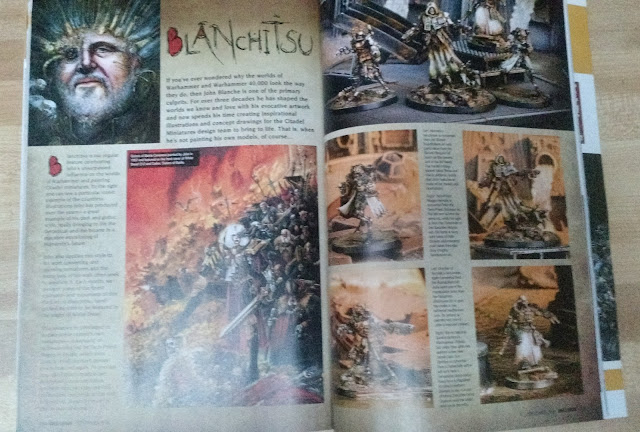As the bottom of the magazine states, it is in fact "Bigger, Better, Brand New"... well, at least the first two. The magazine is fairly long, even by the standards of prior monthly White Dwarfs, and certainly in comparison to the weekly issues. The paper quality is very high, and as you can see from the picture above, it retains the weekly White Dwarf gloss/matte printing for the cover, which can really enhance the picture. Photography is likewise excellent, with none of the muddy backgrounds that sometimes were an issue at the end of the prior monthly era. You will also note that "Games Workshop" does not appear at the top, but rather "Warhmmer", in keeping with recent branding efforts I think.
Another feature is that with more text there is more space for "British-isms", something that this Anglophile appreciates. The White Dwarf of the Paul Sawyer era was full of various references to local culture and turns of phrase, which added to the allure for me. Letters to the editor return as well, including one by a former White Dwarf editor by the name of Guy Haley...
This particular issue has a very large section on adding rules to the boxed games released in the last few years (including Space Hulk 2009/2014). As I have none of the boxed games mentioned, this was interesting but of little use; however I am sure that it would be very interesting to anyone who had one or more of those.
One of the unfortunate aspects of the magazine returning to a monthly format is that advertisements returned as well. As you can see in the picture above the right page is an advertisement for various Warhammer digital products. To be fair, you could call most of the magazine an "advertisement", but new product announcements and the like have at least some use (and more so now that they are more "secret" until the magazine is released.) By my rough count there are 12 pages in this magazine that are solely advertisements for existing products, and therefore have little added value. Certainly not much compared to a non-hobby magazine, but still a bit annoying.Another feature that I missed was the lack of new rules. With the weekly format, miniatures often released before the codex/rulebook to which they belonged, and White Dwarf would fill the gap with the necessary rules. I really enjoyed this feature, as I am unlikely to buy any new codexes, but may buy some of the miniatures for other purposes and games (mostly older GW games anyway). Hopefully this feature comes back (for the rumored Genestealers?) in future issues.
 |
| Blanchitsu - Inq28 |
Anyway, enjoying the magazine very much, and unlike the last few monthly magazines (to say nothing of the weekly pamphlets), I am still reading it. I expect to pick up the next few from my local store, and if things keep up at this level, I will resubscribe for the first time in quite a few years now.










